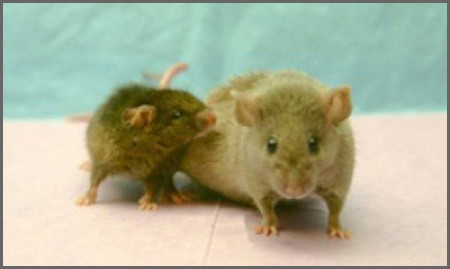NCBI Bookshelf. A service of the National Library of Medicine, National Institutes of Health.
Dean L, McEntyre J, editors. Coffee Break: Tutorials for NCBI Tools [Internet]. Bethesda (MD): National Center for Biotechnology Information (US); 1999-.
Insulin growth factor (IGF-1) is on the World Anti-Doping Agency list of banned substances. In children, IGF-1 is important for growth, and in adults, it continues to have anabolic effects. Although data are lacking for humans, animal studies have shown that IGF-1 can increase muscle mass and speed up healing of injured tendons (1, 2).
IGF-1 also appears to play a part in the aging process. It has long been known that one of the causes of short stature, or dwarfism, is a lack of the IGF-1 hormone in childhood. And now it appears that IGF-1 deficiency also influences longevity.
The C. elegans worm can live for twice as long if it is genetically engineered to have a mutation in daf-2 (equivalent to IGF-1 receptor in humans) (3). And Yoda, a dwarf mouse, lived twice as long as normal laboratory mouse. With Princess Leia (his cage mate) for company, Yoda lived long enough to celebrate his 4th birthday (1).

Yoda, a Snell dwarf mouse (left), sniffing his cage-mate, Princess Leia (right).
Dwarf mice are usually caged with normal-sized mice to help them to keep warm.
Photo credit: Richard Miller, University of Michigan Medical School
Dwarf mice, like the long-living worms, lack IGF-1. These mice are commonly used to study the effects of aging and there are three main types. The Snell and Ames dwarf mice have been bred to inherit mutations in Pit-1 and Prop1 genes, respectively, which disrupt the embryonic development of the pituitary gland. As a result, both types of mice lack multiple hormones, including growth hormone, prolactin, and thyroid stimulating hormone.
The third type of dwarf mouse, the Laron dwarf, is a knock-out mouse model. This mouse has a targeted gene deletion of either the growth hormone receptor (GHR-KO) or the growth hormone binding protein (GHBP-KO). So even though this mouse produces growth hormone, it is still growth-restricted because it is unable to respond to it (4).
Dwarf mice all share non-detectable levels of IGF-1 because one of the main actions of growth hormone is to stimulate the production of IGF-1. Interestingly, in addition to their small size, these mice also have reduced glucose and insulin levels, a lower incidence of tumors, and a longer average and maximum lifespan. In fact, their lifespan is increased by about 40% (4, 5).
Such mouse models are useful, but is there a similar link between IGF-1 deficiency and long-life seen in humans? Individuals with Laron syndrome have been helping to provide this answer. Laron syndrome, also known as primary growth hormone insufficiency, is caused by a mutation in the growth hormone receptor gene. A variety of different mutations have been identified, and most affect the extracellular region of the receptor that contains the growth hormone binding site. Affected individuals are typically less than 4 feet tall, but if they are given IGF-1 before puberty, they may grow taller (6, 7).
In southern Ecuador, there is a village where more than 250 individuals are thought to have Laron syndrome, and this community has been well-studied. The results have been surprising. For example, Laron patients appear to be protected against developing cancer, a disease that is associated with aging (8). Unfortunately, this apparent protection by IGF-1 deficiency does not translate to a longer life span compared to the general population (9). One factor may be a higher death rate from causes of death that are not related to age, such as trauma and alcoholism (10).
So, could targeting IGF-1 be a pathway to the elixir of youth? We know that a certain level of GH and IGF-1 is required for the functioning of the heart and other organs, and the level of these hormones declines with age. However, GH and IGF-1 are oncogenes, and using IGF-1 as a treatment for individuals who do not have a genetic deficiency might lead to unexpected and harmful outcomes (11).
What is clear is that extending the life of any organism, from worm to human, is an incredibly complex process, involving many pathways, and potentially many drug targets. And although IGF-1 may be one of these targets, knowing how to use this treatment safely and effectively remains a long way away.
Acknowledgments
The author would like to thank Zvi Laron, Professor Emeritus of Pediatric Endocrinology, Tel Aviv University, for reviewing this summary.
References
- 1.
- Pobojewski, S. World's oldest mouse reaches milestone birthday. The University Record [Online ] May 1, 2014]; Available from: http://www
.ur.umich.edu /0304/Apr19_04/26.shtml. - 2.
- Kurtz C.A., et al. Insulin-like growth factor I accelerates functional recovery from Achilles tendon injury in a rat model. Am J Sports Med. 1999;27(3):363–9. [PubMed: 10352775]
- 3.
- Chen D., et al. Germline signaling mediates the synergistically prolonged longevity produced by double mutations in daf-2 and rsks-1 in C. elegans. Cell Rep. 2013;5(6):1600–10. [PMC free article: PMC3904953] [PubMed: 24332851]
- 4.
- Bartke A., Brown-Borg H. Life extension in the dwarf mouse. Curr Top Dev Biol. 2004;63:189–225. [PubMed: 15536017]
- 5.
- Flurkey K., et al. Lifespan extension and delayed immune and collagen aging in mutant mice with defects in growth hormone production. Proc Natl Acad Sci U S A. 2001;98(12):6736–41. [PMC free article: PMC34422] [PubMed: 11371619]
- 6.
- Savage M.O., et al. Endocrine assessment, molecular characterization and treatment of growth hormone insensitivity disorders. Nat Clin Pract Endocrinol Metab. 2006;2(7):395–407. [PubMed: 16932322]
- 7.
- Laron, Z., Kopchick, J. (Eds.), Laron Syndrome - From Man to Mouse. Lessons from Clinical and Experimental Experience. 2011: Springer.
- 8.
- Steuerman R., Shevah O., Laron Z. Congenital IGF1 deficiency tends to confer protection against post-natal development of malignancies. Eur J Endocrinol. 2011;164(4):485–9. [PubMed: 21292919]
- 9.
- Aguiar-Oliveira M.H., et al. Longevity in untreated congenital growth hormone deficiency due to a homozygous mutation in the GHRH receptor gene. J Clin Endocrinol Metab. 2010;95(2):714–21. [PMC free article: PMC2840870] [PubMed: 19965916]
- 10.
- Laron Z. The GH-IGF1 axis and longevity. The paradigm of IGF1 deficiency. Hormones (Athens). 2008;7(1):24–7. [PubMed: 18359741]
- 11.
- Werner, H., Attias-Geva, Z., Bentov, I., Sarfstein, R., Schayek, H., Weinstein, D., Bruchim, I., Cancer Genes, Tumor Suppressors, and Regulation of IGF1-R Gene Expression in Cancer, in Insulin-like Growth Factors and Cancer: From Basic Biology to Therapeutics, D.E. LeRoith, Editor. 2012, Springer Science. p. p159-177.
- Yoda and the fountain of youth? - Coffee BreakYoda and the fountain of youth? - Coffee Break
Your browsing activity is empty.
Activity recording is turned off.
See more...
